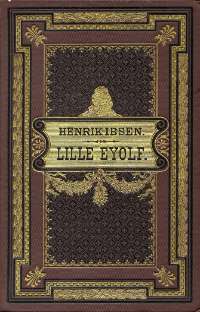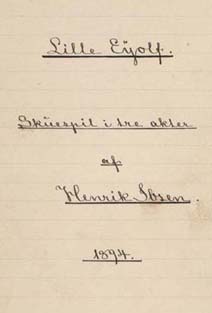

Brief description
Little Eyolf was written in 1894, while Ibsen was living in Victoria Terrasse in Christiania. The planning started in the autumn of 1893. In a letter to Jacob Hegel, dated September 18th 1893, Ibsen wrote: «I have now begun to plan a new drama, which I intend to complete during the coming summer. I find it easy to work here, and it is very pleasant having one's own independent home». [read the letter in HISe]
A letter to his daughter-in-law Bergliot Ibsen shows that he started writing on 14 June 1894. Ibsen then made a large number of corrections and changes in the first draft, before making a fair copy. Several central points were only included in the final version, for example Eyolf's handicap and Almers' expression «the law of transformation». The completed fair copy of the manuscript was sent to the publisher on 13 October 1894.
Little Eyolf was published by Gyldendalske Boghandels Forlag (F. Hegel & Søn) in Copenhagen and Christiania on December 11th 1894 in 10 000 copies, which sold extremely well, and were soon sold out. Only ten days later, on 21 December, another 2 000 copies were published, and 1 250 on January 20th 1895.
As had been the case with Hedda Gabler (1890) and The Master Builder (1892), the English publisher William Heinemann published Little Eyolf in a «mini-edition» of 12 copies in Norwegian in London, in order to secure the copyright. This took place on the same day as the Gyldendal edition, 11 December 1894. Translations into English (by William Archer), French (by Moritz Prozor) and German (by Ibsen's son Sigurd) also came out on that day, in London, Paris and Berlin respectively.
The play's reception by the Scandinavian press was almost exclusively positive.
The first performance of Little Eyolf was at the Deutsches Theater in Berlin on 12 January 1895. The production was directed by Otto Brahm, who had recently been appointed director of the theatre. The parts of Alfred and Rita were played by Emanuel Reicher and Agnes Sorma. The production played to full houses and received a great deal of attention, though its reception was mixed among audiences and critics.
The first performance in Norway was at the Christiania Theater on 15 January, with Ibsen present in the audience. Alfred, Rita and Asta were played by Nicolai Halvorsen, Ragna Wettergren and Johanne Dybwad respectively. 36 performances were given in the course of 1895.
Other productions of the play in January and February 1895 were at:
– Den Nationale Scene, Bergen (21 January)
– Svenska Teatern, Helsingfors (21 January)
– Albert Ranft`s Theatre Company, Gothenburg (30 January)
– Teatro Manzoni, Milan (22 February)
– Burgtheater, Vienna (27 February)
(From ibsen.net)
Plot summary
The play takes place in the course of a day and a half at the home of Rita and Alfred Allmers, near the fjord and some distance from the nearest town. They have a partly paralyzed son of nine, Eyolf. The boy's handicap is the result of a fall in babyhood, when he fell off a table after being left unattended while his parents were totally absorbed in making love. After this accident Alfred Allmers seems to have withdrawn from Rita both sexually and emotionally, and buried himself in his work on «human responsibility», which he considers his vocation and the great work of his life. Rita feels rejected by her husband, and this results in outbursts of violent jealousy of both her son and Alfred's stepsister Asta, to whom he is strongly attached.
The plot develops after Alfred's return from the mountains, where he has decided to give up his work on the treatise, and devote himself entirely to Eyolf's happiness and progress. An old woman, known as «the Rat-woman», arrives at the house and asks whether there is anything «gnawing» there. She offers to lure the rats with her to the fjord so that they drown, but no-one in the house thinks there is anything gnawing there that needs to be disposed. But little Eyolf is fascinated by the sinister Rat-woman and follows her down to the water, where he drowns. The boy's death triggers off crises among those who are left behind. We realize that Alfred is in love with Asta, who in turn has discovered from some old letters left by her mother that Alfred and she are not related at all. She leaves with Borgheim, an engineer who wants to marry her.
After heart-searchings, Rita and Alfred decide to stay together in spite of everything, and to start a new life devoted to caring for the poor children of the district. A social conscience will emerge from their feelings of guilt, their sorrow and the void left by the loss of Eyolf.
(Source: Merete Morken Andersen, Ibsenhåndboken, Gyldendal Norsk Forlag, 1995.)
Read Little Eyolf (in Norwegian)
In the online version of the official Ibsen edition (HISe), you can read Little Eyolf in various formats. This content is currently only available in Norwegian. Follow the links below to read the play:
Introduction to the work (in Norwegian)
The online version of the official Ibsen edition (HISe) offers extensive information about Little Eyolf in Norwegian. Follow the links below to read about various aspects connected to the play.
- Background
- Creative process
- About the publication
- Stagings in Ibsen's life time
- Parodies in Ibsen's life time
- More information
Reviews
Here you can find reviews in full text and an overview of registered reviews in various languages.
- Reviews from Ibsen's life time in full text
- Reviews registered in the Ibsen bibliography (nb.no)
- Reviews registered in "Norsk litteraturkritikk" (UiO)
Translations
- The Multilingual Ibsen
- Translations in various languages
- Overview of translations from Ibsen's lifetime (HISe)